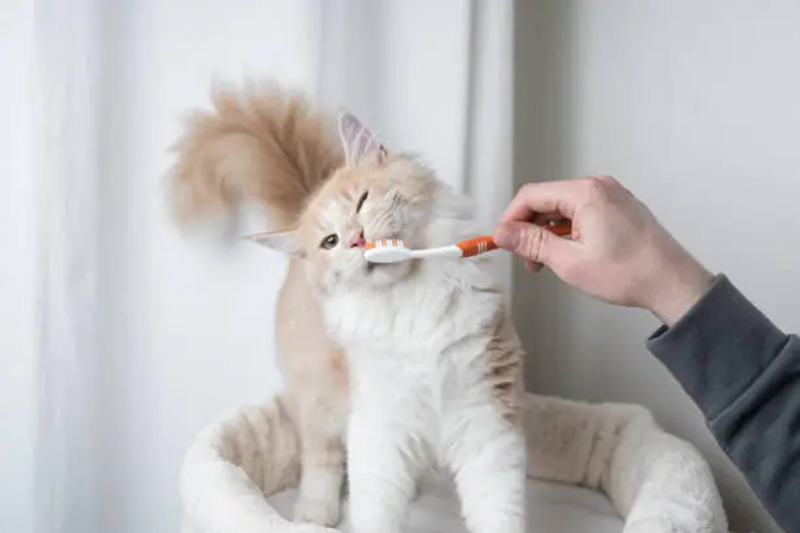A Step-by-Step Guide: How to Improve Cat Dental Health at Home
Published on June 26, 2025

When we think about our cat's health, we often focus on their diet, coat, and activity levels. However, one of the most overlooked yet critical aspects of their overall wellbeing is their dental health. Dental disease is incredibly common in cats, with studies showing that a majority of cats over the age of three have some form of it. Left untreated, it can lead to pain, tooth loss, and even systemic health issues affecting the heart, kidneys, and liver.
The good news is that proactive at-home care can make a world of difference. This guide will provide you with a step-by-step approach to improving and maintaining your cat's dental hygiene, helping them live a longer, healthier, and pain-free life.
Recognizing the Signs of Dental Problems
Cats are masters at hiding pain, so it's important for owners to be vigilant. Telltale signs of dental issues include:
- Bad Breath (Halitosis): This is often the first and most common sign.
- Red, Swollen, or Bleeding Gums: Healthy gums should be pink and firm.
- Pawing at the Mouth or Drooling: This can indicate pain or discomfort.
- Difficulty Eating: Your cat might drop food, chew on only one side of their mouth, or avoid hard food altogether.
- Visible Tartar: A yellow or brown buildup on the teeth, especially the molars.
- Changes in Behavior: Irritability or reclusiveness can be linked to chronic pain.
The Gold Standard: At-Home Teeth Brushing
Brushing your cat's teeth is the single most effective way to remove plaque before it hardens into tartar. While it may sound daunting, many cats can learn to accept, and even enjoy, the process with patience and positive reinforcement.
Step 1: Gather Your Supplies
You will need a toothpaste specifically formulated for cats (never use human toothpaste, as it can be toxic) and a soft-bristled toothbrush designed for felines or a finger brush.
Step 2: Introduce the Toothpaste
Start by letting your cat lick a small amount of the feline toothpaste off your finger. Choose a flavor they enjoy, like poultry or malt. Do this for a few days so they associate the toothpaste with a positive treat.
Step 3: Introduce the Toothbrush
Once they accept the toothpaste, let them lick it off the toothbrush. This helps them get used to the tool itself without any pressure.
Step 4: Gentle Brushing
In a calm and quiet setting, gently lift your cat's lip and brush one or two of the outer surfaces of their teeth in a circular motion. Focus on the outside surfaces, as that's where most tartar accumulates. Reward them immediately with praise or a treat. Keep these initial sessions very short (15-30 seconds).
Step 5: Gradually Increase Duration
Over several weeks, gradually increase the number of teeth you brush until you can clean all the outer surfaces in about a minute. Aim for daily brushing, but even three times a week can make a significant impact.
Other At-Home Dental Care Options
If brushing isn't feasible, or if you want to supplement your efforts, consider these other options:
- Dental Diets and Treats: Look for foods and treats that have the Veterinary Oral Health Council (VOHC) seal of approval. These are specially designed with a texture that helps scrape plaque off the teeth as your cat chews.
- Water Additives: These are tasteless solutions that you can add to your cat's water bowl to help reduce plaque and freshen breath.
- Dental Gels and Sprays: These products can be applied directly to the teeth and gums to help inhibit bacteria and plaque formation.
The Importance of Professional Veterinary Cleanings
At-home care is for prevention, but it cannot remove existing tartar. Just like humans, cats require periodic professional dental cleanings from a veterinarian. During these cleanings, your cat will be safely placed under anesthesia, allowing the vet to perform a thorough examination, take dental X-rays to see below the gumline, and use ultrasonic scalers to remove all plaque and tartar. This is an essential part of a complete dental health strategy.
By combining regular at-home care with professional veterinary cleanings, you can protect your cat from the pain of dental disease and contribute to their overall health and longevity.